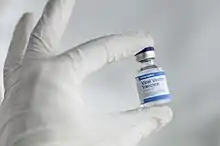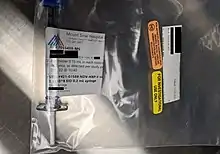Viral vector vaccine
A viral vector vaccine is a vaccine that uses a viral vector to deliver genetic material (mRNA) coding for a desired antigen into the recipient's host cells. As of April 2021, six viral vector vaccines have been authorized for use in humans in at least one country: four COVID-19 vaccines and two Ebola vaccines.

Technology
Viral vector vaccines use a modified version of one virus as a vector to deliver to a cell a nucleic acid coding for an antigen for another infectious agent. Viral vector vaccines do not cause infection with either the virus used as the vector, or the source of the antigen. The genetic material it delivers does not integrate into a person's genome.[1]
Viral vector vaccines enable antigen expression within cells and induce a robust cytotoxic T cell response, unlike subunit vaccines which only confer humoral immunity. Most viral vectors are designed to be incapable of replication because the necessary genes are removed.[2]
Vector viruses
Adenovirus
Adenovirus vectors have the advantage of high transduction efficiency, transgene expression, and broad viral tropism, and can infect both dividing and non-dividing cells. A disadvantage is that many people have pre-existing immunity to adenoviruses due to previous exposure. Human adenovirus serotype 5 is often used because it can be easily produced in high titers.[2]
As of April 2021, four adenovirus vector vaccines for COVID-19 have been authorized in at least one country:
- The Oxford–AstraZeneca vaccine uses the modified chimpanzee adenovirus ChAdOx1[3][4]
- Sputnik V uses human adenovirus serotype 26 for the first shot and serotype 5 for the second.[5][6]
- The Janssen vaccine uses serotype 26.[7][8][9]
- Convidecia uses serotype 5.[10][11]
Zabdeno, the first dose of the Zabdeno/Mvabea Ebola vaccine, is derived from human adenovirus serotype 26 expressing the glycoprotein of the Ebola virus Mayinga variant.[12] Both doses are non-replicating vectors and carry the genetic code of several Ebola virus proteins.[13]
Others

The rVSV-ZEBOV vaccine is an Ebola vaccine. It is a recombinant, replication-competent vaccine[15] consisting of vesicular stomatitis virus (VSV) genetically engineered[16] so that the gene for the natural VSV envelope glycoprotein is replaced with that from the Kikwit 1995 Zaire strain Ebola virus.[17][18][19]
Mvabea, the second dose of the Zabdeno/Mvabea Ebola vaccine, is a modified vaccinia Ankara vector, a type of poxvirus.[12] Both doses are non-replicating vectors and carry the genetic code of several Ebola virus proteins.[13]
Other viruses that have been investigated as vaccine vectors include adeno-associated virus, retrovirus (including lentivirus), cytomegalovirus, Sendai virus, and avulavirus,[2][20] as well as influenza virus and measles virus.[1]
History
Human clinical trials were conducted for viral vector vaccines against several infectious diseases including Zika virus, influenza viruses, respiratory syncytial virus, HIV, and malaria, before the vaccines targeting SARS-CoV-2, which causes COVID-19.[1]
Two Ebola vaccines using viral vector technology were used in Ebola outbreaks in West Africa (2013–2016) and in the Democratic Republic of the Congo (2018–2020).[1] The rVSV-ZEBOV vaccine was approved for medical use in the European Union in November 2019,[21] and in the United States in December 2019.[22][23] Zabdeno/Mvabea was approved for medical use in the European Union in July 2020.[13][24][25]
References
- "Understanding and Explaining Viral Vector COVID-19 Vaccines". U.S. Centers for Disease Control and Prevention. 25 February 2021. Retrieved 2 April 2021.
- Ura T, Okuda K, Shimada M (July 2014). "Developments in Viral Vector-Based Vaccines". Vaccines. 2 (3): 624–41. doi:10.3390/vaccines2030624. PMC 4494222. PMID 26344749.
- Clinical trial number NCT04400838 for "Investigating a Vaccine Against COVID-19" at ClinicalTrials.gov
- "A Phase 2/3 study to determine the efficacy, safety and immunogenicity of the candidate Coronavirus Disease (COVID-19) vaccine ChAdOx1 nCoV-19". EU Clinical Trials Register. European Union. 21 April 2020. EudraCT 2020-001228-32. Archived from the original on 5 October 2020. Retrieved 3 August 2020.
- Corum J, Carl Z (8 January 2021). "How Gamaleya's Vaccine Works". The New York Times. Retrieved 27 January 2021.
- Clinical trial number NCT04436471 for "An Open Study of the Safety, Tolerability and Immunogenicity of the Drug 'Gam-COVID-Vac' Vaccine Against COVID-19" at ClinicalTrials.gov
- Clinical trial number NCT04436276 for "A Study of Ad26.COV2.S in Adults" at ClinicalTrials.gov
- Clinical trial number NCT04505722 for "A Study of Ad26.COV2.S for the Prevention of SARS-CoV-2-Mediated COVID-19 in Adult Participants" at ClinicalTrials.gov
- FDA Briefing Document Janssen Ad26.COV2.S Vaccine for the Prevention of COVID-19 (PDF) (Report). U.S. Food and Drug Administration (FDA).
- Zhu FC, Guan XH, Li YH, Huang JY, Jiang T, Hou LH, et al. (August 2020). "Immunogenicity and safety of a recombinant adenovirus type-5-vectored COVID-19 vaccine in healthy adults aged 18 years or older: a randomised, double-blind, placebo-controlled, phase 2 trial". Lancet. 396 (10249): 479–88. doi:10.1016/S0140-6736(20)31605-6. PMC 7836858. PMID 32702299.
- Clinical trial number NCT04566770 for "Phase IIb Clinical Trial of A COVID-19 Vaccine Named Recombinant Novel Coronavirus Vaccine (Adenovirus Type 5 Vector)" at ClinicalTrials.gov
- Clinical trial number NCT02313077 for "A Safety and Immunogenicity Study of Heterologous Prime-Boost Ebola Vaccine Regimens in Healthy Participants" at ClinicalTrials.gov
- "Johnson & Johnson Announces European Commission Approval for Janssen's Preventive Ebola Vaccine" (Press release). Johnson & Johnson. 1 July 2020. Retrieved 16 July 2020.
- "Mount Sinai Launches Phase 1 U.S. Trial of NDV-HXP-S, an Egg-Based Investigational COVID-19 Vaccine, in Healthy Adults Previously Immunized Against COVID-19". Icahn School of Medicine at Mount Sinai. 21 March 2022. Archived from the original on 13 July 2022. Retrieved 13 July 2022.
- Marzi A, Ebihara H, Callison J, Groseth A, Williams KJ, Geisbert TW, Feldmann H (November 2011). "Vesicular stomatitis virus-based Ebola vaccines with improved cross-protective efficacy". The Journal of Infectious Diseases. 204 Suppl 3 (suppl 3): S1066–74. doi:10.1093/infdis/jir348. PMC 3203393. PMID 21987743.
- "Ervebo (Ebola Zaire Vaccine, Live) Suspension for intramuscular injection" (PDF). Merck Sharp & Dohme.
- Martínez-Romero C, García-Sastre A (November 2015). "Against the clock towards new Ebola virus therapies". Virus Research. 209: 4–10. doi:10.1016/j.virusres.2015.05.025. PMID 26057711.
- Choi WY, Hong KJ, Hong JE, Lee WJ (January 2015). "Progress of vaccine and drug development for Ebola preparedness". Clinical and Experimental Vaccine Research. 4 (1): 11–16. doi:10.7774/cevr.2015.4.1.11. PMC 4313103. PMID 25648233.
- Regules JA, Beigel JH, Paolino KM, Voell J, Castellano AR, Hu Z, et al. (January 2017). "A Recombinant Vesicular Stomatitis Virus Ebola Vaccine". The New England Journal of Medicine. 376 (4): 330–41. doi:10.1056/NEJMoa1414216. PMC 5408576. PMID 25830322.
- Zimmer, Carl (2021-04-05). "Researchers Are Hatching a Low-Cost Coronavirus Vaccine". The New York Times.
{{cite news}}: CS1 maint: url-status (link) - "Ervebo EPAR". European Medicines Agency (EMA). 12 December 2019. Retrieved 1 July 2020. Text was copied from this source which is © European Medicines Agency. Reproduction is authorized provided the source is acknowledged.
- "First FDA-approved vaccine for the prevention of Ebola virus disease, marking a critical milestone in public health preparedness and response". U.S. Food and Drug Administration (FDA). 19 December 2019. Archived from the original on 20 December 2019. Retrieved 19 December 2019.
 This article incorporates text from this source, which is in the public domain.
This article incorporates text from this source, which is in the public domain. - "Ervebo". U.S. Food and Drug Administration (FDA). 19 December 2019. Retrieved 1 July 2020.
- "Zabdeno EPAR". European Medicines Agency (EMA). 26 May 2020. Retrieved 23 July 2020.
- "Mvabea EPAR". European Medicines Agency (EMA). 26 May 2020. Retrieved 23 July 2020.
Further reading
- Ewer KJ, Lambe T, Rollier CS, Spencer AJ, Hill AV, Dorrell L (August 2016). "Viral vectors as vaccine platforms: from immunogenicity to impact". Current Opinion in Immunology. 41: 47–54. doi:10.1016/j.coi.2016.05.014. PMID 27286566.